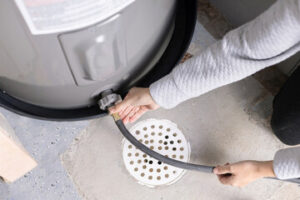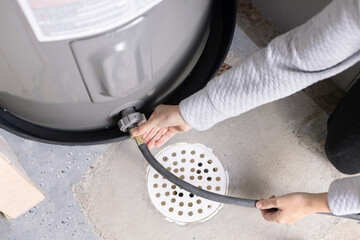If the rust is extensive, the tank is overdue for replacement. Leaks from the tank can cause severe water damage. For professional help, contact Hot Water Heater Replacement Denver now!
To remove the old unit, turn off your water supply (at the main or isolation valve on the incoming cold water line) and drain the tank using a garden hose. Disconnect the water lines using a pipe wrench or channel-lock pliers (for compression or union fittings).
A water heater’s anode rod is an unsung hero, protecting the tank from corrosion by attracting and eating away at the more corrosive minerals found in your home’s water. It’s important to inspect your anode rod regularly and replace it when necessary.
The longevity of an anode rod depends on your home’s water quality, usage, and the material used to construct it. Generally speaking, however, an anode rod should be replaced every three to five years. A physical inspection will reveal if the rod has suffered severe wear; it should not be heavily corroded or significantly thinner than it originally was. A thinning rod is also an indicator that it’s time to switch to a new one, as it will no longer be effective in protecting the tank lining.
Anode rods are typically made from magnesium or aluminum, or a zinc-aluminum alloy. The type of anode rod you choose will depend on your water’s hardness and pH level. Magnesium rods suit most conditions, while aluminum is suitable for soft or low pH water.
Replacing the anode rod is a simple task that can be performed by a homeowner, though it requires a water heater to be drained and may require tools such as a breaker bar. If you are not comfortable performing this task on your own, it is advisable to seek the assistance of a professional plumber or HVAC technician. A professional will have the tools, knowledge, and experience to perform this job quickly and safely. In addition, the plumber will likely drain and flush your water heater as well, a process that can further extend the life of your anode rod. This can also help reduce the frequency of future anode rod replacements.
Dip Tube
If you’ve lost access to hot water and found a residue of small plastic bits around faucets and showerheads, the problem may lie with your dip tube. This short piece of pipe carries cold water into your hot water heater to push it down towards the bottom to be heated. Then it churns the hot and cold water to keep a steady supply flowing through your plumbing. But just like anode rods, dip tubes wear out and need to be replaced. Fortunately, it’s an easy and inexpensive fix.
Corrosion is one of the main culprits in shortening the lifespan of your dip tube. It happens because minerals in hard water attack the plastic and break it down over time. It’s also worn out by repeated exposure to very hot water. Another reason your dip tube might wear out is if it’s cracked or damaged. This can allow cold water to escape the tube and mingle with the hot, causing your water temperature to drop.
Replacing your water heater’s dip tube is fairly simple. First, you’ll want to turn off the power to your hot water heater. This is important because you could get an electric shock if you don’t. Next, drain your tank to remove any plastic flecks that have formed. Now you can disconnect the cold water pipe and the pipe nipple at the top of your tank, and then remove the dip tube by turning it counterclockwise with a screwdriver.
Now that your old dip tube is removed, simply install a new one. Make sure to use a tube made from a durable material, like cross-linked polyethylene PEX, and that it extends down all the way to the bottom of your tank. After you’ve installed the new tube, connect it to the cold water inlet and reconnect the cold water supply line, and then restore power to your tank and turn on the gas.
Thermostat
A thermostat is an essential part of your water heater that ensures your home is always receiving the right temperature. It’s not uncommon for homeowners to experience problems with their thermostat, but there are a few things you can try before replacing the unit entirely. To begin, make sure the breaker hasn’t been tripped. If it has, switch it off and on again. If the problem persists, you’ll need to replace your thermostat.
To do so, you’ll need to have a few tools and materials available. Essentials include screwdrivers, a multimeter and a replacement thermostat. Once you’ve gathered these items, shut off the power to your water heater by turning off the circuit breaker. Then, remove the screws from the access panel and take off the plastic safety cover to expose the upper and lower heating elements and thermostat. Make sure to label the wires connected to each before removing them so you can reconnect them properly later on. Next, use a multimeter to check if there’s any power on the upper element terminal screws.
If the meter reads no voltage, your thermostat is likely defective. However, if the reading is fine and the heater seems to be working fine, the problem may lie elsewhere. It’s also possible that your breaker has tripped, in which case you’ll need to reset it.
When buying a new thermostat, be sure to select the same model and style as your old one. Having the same type and model will help ensure that your new one is properly installed and is compatible with your heater. Once you’ve finished replacing the thermostat, screw it evenly down into its holding bracket and reinstall the access panel and safety cover.
Element
The heating element is the most important component of a water heater, as it’s responsible for heating and distributing hot water throughout the home. It’s also the longest-lasting part of a water heater, lasting about 10 to 15 years on average. However, as with any electric device, the elements aren’t designed to last forever, and it’s not uncommon for them to malfunction or fail due to a variety of reasons.
Luckily, it’s fairly easy to identify the sign of a faulty heating element. Common symptoms include a lack of hot water or a constant tripping circuit breaker, both of which can be caused by a failing element pulling too much electricity. A visual inspection can be helpful, as well; signs of corrosion and damage on the element are often clear indicators that it’s time to replace it.
Before you begin the repair process, it’s imperative to shut off the power to your water heater. You’ll also want to drain the tank partially or completely (depending on the position of the heating element) by connecting a garden hose to the drain valve located at the bottom of the water heater and running it until it’s empty. This step will prevent any water from splashing onto or damaging the new element as you’re removing and replacing it.
Once the water heater is drained, you’ll be able to remove the element by disconnecting the electrical wires from it. If the element is a screw-in type, you’ll need to unscrew it using a ratchet wrench or a socket that fits the size of the heating element. After the old element is removed, install your new one by threading it into the hole and tightening it with a socket wrench or ratchet.
Pressure Valve
The pressure valve (T&P) is a critical component of hot water heaters, as it alleviates excess pressure from within the tank, protecting your home from potential tank bursts and leaking. In fact, the T&P valve is an important safety feature that should be tested every year to ensure it’s working properly.
When the inlet pressure rises above the set pressure of the valve, the compression of the spring overcomes this force and the valve opens, diverting the flow through a port or directly to atmosphere, depending on the configuration. The valve will close when the inlet pressure returns to its set point.
It’s important to select the right valve for your application, as the piping, temperature and pressure range will determine which type of valve is appropriate. Consult with an expert or manufacturer if you’re unsure what type of valve is best for your project.
Before installing a pressure relief valve, make sure the discharge pipe is connected to a drain and that the valve is not installed over a hot water or steam line. The valve should also be positioned with its body at least 2 inches above the ground to avoid contamination and to facilitate serviceability.
Once the pressure valve is in place, turn off the water supply to your home at the main shutoff valve or at the isolation valve on the incoming cold water line. Then disconnect and remove the old water heater from its location, ensuring all connections are clean and dry. Position the new water heater and connect its temperature and pressure relief valve, discharge drainpipe, gas line, and electric terminals according to the manufacturer’s directions. Once the valves are in place, test by brushing soapy water over all plumbing joints and connecting points.



